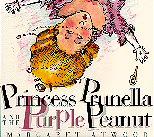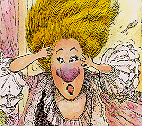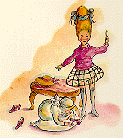


|
Princess Prunella and the Purple Peanut.
Margaret Atwood. Illustrated by Maryann Kovalski.
Toronto: Key Porter Kids, 1995. 32pp, paper, $16.95.
ISBN 1-55013-732-8.
Grades 1 - 3 / Ages 6 - 9.
Review by Leslie Millar.
|
excerpt:
In the morning the three plump pussycats poked and pinched Princess
Prunella awake with their pointy paws. ``We pity you," they whispered.
``Your eyes are all pink and puffy, and that purple peanut is as big as a
pumpkin. So we will remind you of what the white-haired wrinkly-wristed
Wise Woman said: Perform three Good Deeds and your purple peanut will
pop."
``What are Good Deeds?" said Prunella.
``You are a perverse pie-faced pudding-brain," said the three
pussycats politely, padding pompously away on their polished paws. ``You
should have paid more attention!"
 Margaret Atwood is well known to adults as the author of more than
twenty-five books of poetry, fiction, and non-fiction. She is not,
however, a complete newcomer to the children's scene. Princess
Prunella and the Purple Peanut marks her fourth foray into the
world of children's literature. (Her previous titles are Anna's
Pet, Up in the Tree, and For the Birds.)
Margaret Atwood is well known to adults as the author of more than
twenty-five books of poetry, fiction, and non-fiction. She is not,
however, a complete newcomer to the children's scene. Princess
Prunella and the Purple Peanut marks her fourth foray into the
world of children's literature. (Her previous titles are Anna's
Pet, Up in the Tree, and For the Birds.)
Modelled as a moral fairy tale, the problems in Princess
Prunella arise from the Princess's selfish nature. She is
completely preoccupied with her own beauty, disdainful of servants, and
cruel to her pets. Her day of reckoning comes in an encounter with a Wise
Woman, who poses as a poor person in need of food. True to form, Prunella
rebuffs her and lets her know how distasteful she finds poor people. The
Wise Woman casts a spell on Prunella, giving her a purple peanut for a
nose. To break the spell, the Princess must perform three good deeds --
but she doesn't even know what a good deed is.

Needless to say, Prunella matures in the course of the story. She
learns that it's what's inside that counts, and in the end she finds
happiness by thinking of others.
Princess Prunella will work best as a ``read-aloud"
book. The complex sentence structure and advanced vocabulary may prove
difficult, but reading aloud, with the illustrations for context, will
clarify the fanciful wording. Reading aloud also allows the reader to
demonstrate how words can be played with for fun. A warning, however --
even the most limber tongue will probably trip over Atwood's endless
purple alliterations.

During my second reading of Princess Prunella I
started to feel a bit annoyed, even bored. I just didn't want to wade
through all those ``P" words again. I began to suspect a case of style
over substance, any substance being swamped by the tiresome cleverness of
the style. On the other hand, this book should top any list of phonetic
lessons for the letter ``P."
The full and half-page illustrations on slick paper are filled with
humour and whimsy that are sure to please all ages. Beautifully coloured
in muted tones, and packed with detail befitting a princess's
surroundings, the pictures are as much a story as the text.
Leslie Millar is a substitute teacher/volunteer in Winnipeg schools.

Copyright © 1995 the Manitoba Library Association.
Reproduction for personal use is permitted only if this copyright notice
is
maintained. Any other reproduction is prohibited without permission.
Published by
The Manitoba Library Association
ISSN 1201-9364
 Go back to CM Welcome page
Go back to CM Welcome page
 Go back to Table of
Contents for this Issue
Go back to Table of
Contents for this Issue



 Margaret Atwood is well known to adults as the author of more than
twenty-five books of poetry, fiction, and non-fiction. She is not,
however, a complete newcomer to the children's scene. Princess
Prunella and the Purple Peanut marks her fourth foray into the
world of children's literature. (Her previous titles are Anna's
Pet, Up in the Tree, and For the Birds.)
Margaret Atwood is well known to adults as the author of more than
twenty-five books of poetry, fiction, and non-fiction. She is not,
however, a complete newcomer to the children's scene. Princess
Prunella and the Purple Peanut marks her fourth foray into the
world of children's literature. (Her previous titles are Anna's
Pet, Up in the Tree, and For the Birds.)

![]()
 Go back to CM Welcome page
Go back to CM Welcome page Go back to Table of
Contents for this Issue
Go back to Table of
Contents for this Issue